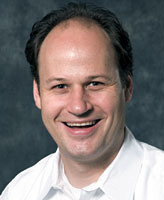| |
 |
| |
© Evanston
Photographic
Professor
J. Peter Murmann |
| |
|
| |
 |
| |
|
| |
|
Faculty
Bookshelf
What makes global players?
Prof. J. Peter Murmann finds institutional
environment key to commercial success for national industries
By Ed Finkel
To understand what makes companies succeed
over the long term in global markets, one must evaluate not
only their capabilities but also the institutional environment
in which they operate.
So says
Kellogg Assistant Professor J. Peter Murmann, whose book,
Knowledge and Competitive Advantage: The Coevolution of
Firms, Technology, and National Institutions (Cambridge
UP, 2003) tracks the synthetic dye industry in the United
States, Britain and Germany from 1857 through 1914.
"The text is directed toward academics,
but it's also for people in charge of firm strategy in high-tech
industries, and R&D directors who want ideas on how to
analyze their competitive position," Murmann says. "There
are huge differences in the institutional and social environment
of countries. You need to master those if you want to implement
effective strategies."
To analyze the dye industry, Murmann
spent nine years collecting data on all such firms, combing
through trade directories, exhibitions and other sources
with help from a historian of technology at the University
of Maastricht. He focused on Germany, Britain and the United
States and looked at all firms that ever participated in
the industry. He also analyzed the life histories of top-
and bottom-performing firms from each country.
"I acted as an industrial archaeologist.
I looked at a lot of dead firms," Murmann says. "I had to
limit my analysis to the most important countries because,
since I perform comparative institutional analyses of these
countries, I had to know a great deal about institutional
makeup of these nations over time. I'm trying to explain
why national industries often differ so much in their global
success."
Murmann found that although Britain had
both the raw materials and the largest market, within a decade
Germany had established the dominant position. He found two
key reasons: The university system in Germany trained more
chemists and turned out the most cutting-edge research, while
the lack of a patent system allowed more firms to freely
enter the synthetic dye market, forcing them to build their
capabilities through competition.
"Most of the innovations in this industry
were developed for the first 25, 30 years not in firms but
in academic laboratories," he says. And while American and
British firms enjoyed patent protection for a while, "When
their monopolies expired, the agile and very capable German
firms Ö just clobbered the ex-monopolists."
This success
of German firms is based on the notion of coevolution among
processes linking companies,
technology and national institutions, Murmann says. "Germany
had the largest number of firm entrants into the industry
in that period, but it also had the largest number of failures," he
says. "If you shoot 100 times, you're more likely to hit
once than if you shoot once."
Once German
firms began to establish competitive advantage, their dominance
snowballed because
they had the money to invest in product development and political
clout to lobby for more university laboratory space and a
more favorable regulatory environment, Murmann says. "Over
time, you explain the big diversion in performance because
you have these self-reinforcing processes," he says.
Murmann chose the synthetic dye industry
for his research from among nine possibilities because it
was the first science-based industry in the sense that little
time passed between scientific discovery and a resulting
commercial product, he says. The book's findings have played
out in other industries, from computing to biotechnology,
Murmann believes.
"You couldn't understand the dominance
of American computer or software firms if you did not know
that it was the Cold War and the Pentagon that initially
funded virtually all the computer science departments," he
says.
Biotechnology
has even more parallels, Murmann contends. "Access to scientific
talent among university researchers is absolutely crucial.
If you're trying to answer
the question, 'Given that I'm in a certain country, what
are the chances I can compete in biotech versus a firm from
another country,' this book gives you some ideas."
Murmann plans to continue similar research
developing studies on several industries which differ in
important respects.
"So then,
any time you look at a current industry you can ask yourself,
'To
what extent is this contemporary
industry perhaps similar to an industry that started 150
years ago and therefore will undergo many of the same competitive
dynamics?'
"Allocating a bit of time to the study
of business history will yield very high returns for managers," Murmann
concludes, "because, as George Santayana warned long ago,
'those who fail to learn the lessons of the past condemn
themselves to repeat its errors.'"
|





